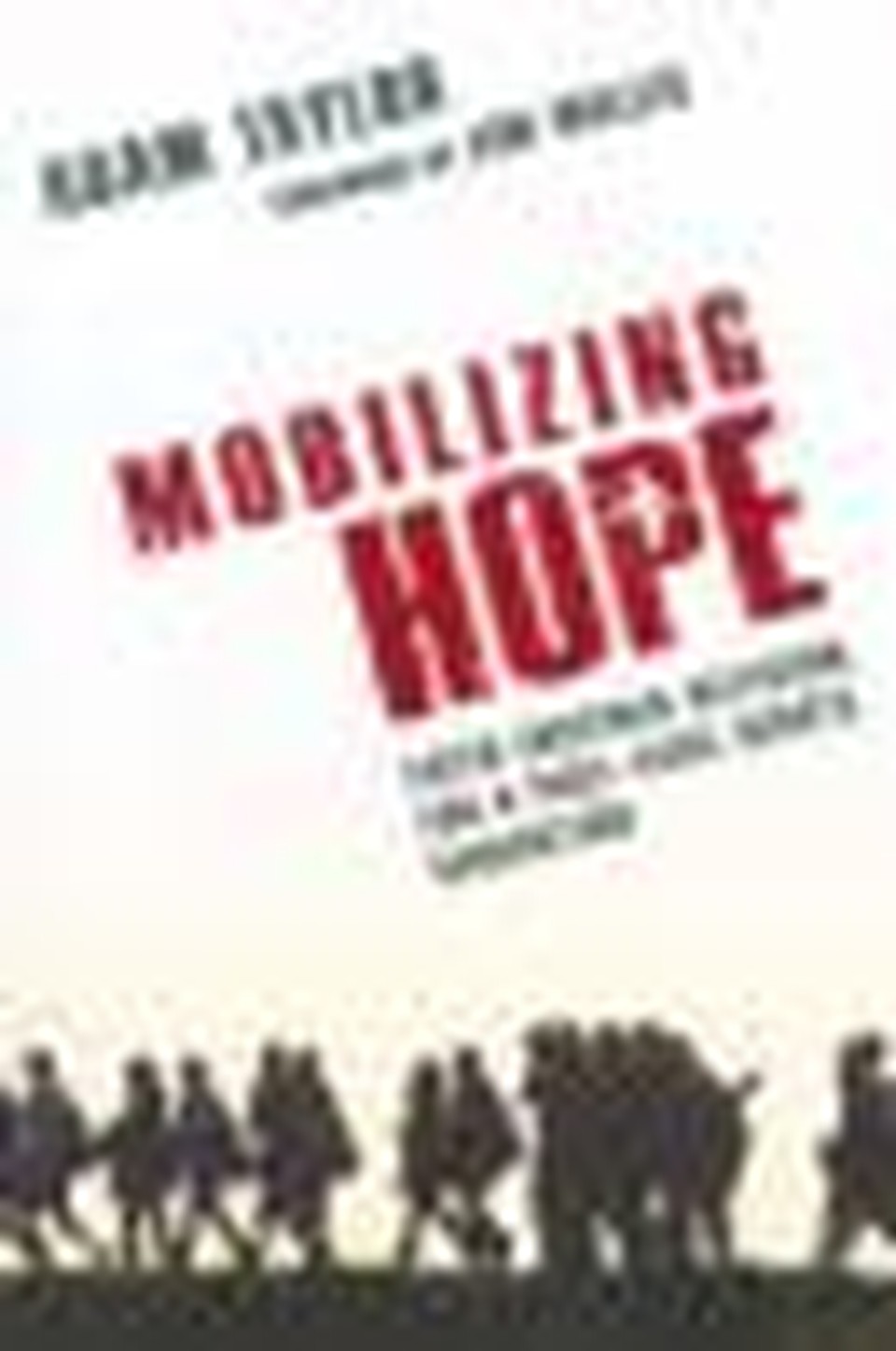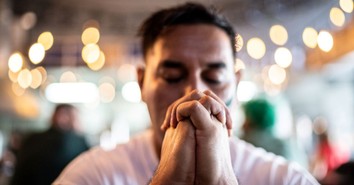Getting to the Root Cause of Injustice, Part II

EDITOR'S NOTE: The following is an excerpt from Mobilizing Hope: Faith-Inspired Activism for a Post-Civil Rights Generation by Adam Taylor (IVP).
The Kingdom of God and Themes of Injustice
Concepts of justice in the New Testament are inextricably tied to an understanding of the kingdom of God. The kingdom of God serves as a central motif describing Christ's mission and witness to the world. Jesus began his ministry announcing that the kingdom of God was at hand (Mark 1:15). The kingdom becomes both a future event and a present reality. God's reign is inaugurated in Jesus Christ, even if its ultimate consummation remains a future event.15 While God has already won final victory over the kingdom of the world through Jesus' death on the cross, this victory is not yet fully realized until the kingdom of the world becomes once more the kingdom of our Lord and God's reign is made complete.
God seeks to enlist us in the project of building God's kingdom, enabling disciples to get a foretaste of the joy of kingdom living. The kingdom is characterized by "shalom," which includes social justice, peace and righteousness. In Kingdom Ethics, Glen Stassen and David Gushee outline four themes of injustice that Jesus addressed through his teachings and witness. Each theme echoes the prophet Isaiah, the book of Psalms and, to a lesser degree, Genesis and Deuteronomy, including unjust economic structures, unjust domination, unjust violence and unjust exclusion from community. Each represents both a type of injustice and a root cause behind injustice.16 As we examine and excavate injustices locally and globally we will find these root causes in different degrees and combinations.
First, Jesus addressed the injustice of greed and exploitation. Jesus' most dramatic confrontation with exploitation takes place in Mark 11, when he enters the temple and, in a radical and provocative act, overturns the tables of the money changers. Jesus has just made his triumphal entry into Jerusalem on what we now celebrate as Palm Sunday, riding into the city on a donkey as the people proclaim, "Hosanna in the highest." Jesus' next public act is to enter the temple, where he sees money changers conducting their business and merchants selling doves. In the time of Jesus, the temple operated as the central bank, a place of commerce in which money changers collected interest and fees for the exchange and borrowing of money. During the time of Passover it was common for money changers and merchants to do big business in the temple, often charging inflated exchange rates. Religious leaders would also sell doves at an exorbitant price to be used as religious sacrifices. Jesus' righteous anger is directed both at the temple being defiled by commerce and at commerce that exploits God's people. Jesus quotes the prophet Jeremiah, saying, "Is it not written, ‘My house shall be called a house of prayer for all the nations'? But you have made it a den of robbers" (Mark 11:17 NRSV). Jesus' words are revealing. To be robbed means that someone is being abused or that something is being stolen by force or deception. Therefore, the cleansing of the temple becomes a prophetic and symbolic attack on the whole temple system for practicing injustice—the same kind of confrontation offered by both Isaiah 56 and Jeremiah 7.
I often wonder how Jesus would confront modern-day forms of greed and exploitation, whether sweatshop labor, illegitimate and odious debt owed by countries in the Global South to wealthy countries and multilateral banks, modern forms of usury such as payday loans, or the reckless speculation and profiteering that spurred the 2008 global financial collapse. While significant progress has been made thanks to greater public awareness, a great deal of the clothes we wear and products we purchase are still produced under inhumane and intolerable "sweatshop" conditions around the world. These include unsafe work environments, excessive work hours, the exploitation of child labor and brutality toward workers. Many countries accumulated a great deal of unsustainable debt under the auspices of the Cold War, taking out loans that were rarely used for their original purpose and instead lined the pockets of corrupt and dictatorial governments. Despite having paid off the equivalent of the principal, many countries are still paying off these debts due to compound interest—spending more money on debt financing than on health care for their people. Payday loan centers have become almost as common as liquor stores in most inner-city neighborhoods, charging outrageous interest rates on short-term loans. The 2008 financial collapse was precipitated by an overvalued and overheated housing market driven by subprime mortgages and bundled loans. Profit-maximization became the primary end, even if the means of excessive risk taking and speculation placed the entire economy at risk.
We can combat these contemporary forms of exploitation through the power of our consumer choices and political and economic pressure. For instance, transnational corporations rely upon the credibility and integrity of their brand to sell their products. Thus, campaigns that tarnish their image and change consumer behavior represent a significant threat. The campaign around conflict diamonds provides a recent example in which consumer activism was successful in reforming the way in which a major industry conducts its business. As Kanye West sings, "diamonds are forever" and have resulted in a lucrative business with potentially destructive consequences. Global Witness's "Combating Conflict Diamonds" campaign, which was launched in 1998, exposed the role of diamonds in funding conflicts in places like Sierra Leone and the Congo. The campaign put the diamond industry, previously shrouded in secrecy, into the international spotlight, demanding that governments and the diamond industry take action to eliminate the trade in conflict diamonds. In response, in May 2000, the major diamond trading and producing countries, representatives of the diamond industry and NGOs met in Kimberley, South Africa, to determine how to tackle the conflict diamond problem. The meeting was the start of an important and often contentious three-year negotiating process to establish the Kimberley Process, an international diamond certification scheme.18 A concerted public campaign by a coalition of NGOs successfully exposed the nefarious connection between diamond companies and bloody conflicts, compelling companies to put in place more stringent standards and monitoring systems.
Second is the root cause of domination and powerlessness. Jesus was a poor Jew living within the context of Roman occupation and oppression. Jesus' words and actions must be understood within this oppressive context; otherwise, we can lose the deeper meaning and significance behind his parables and teachings, and we risk over-sanitizing the more radical implications of Jesus' words. One illustration of why we must get underneath the meaning of Jesus' words is the story in Mark 5 in which Jesus exorcises the unclean spirit called "Legion." At the time Jesus lived, "legion referred to none other than the Roman legions, the powerful and brutal Roman army occupying Israel. What is commonly viewed as purely an exorcism turns out to also be a parable indicting the Roman military for its oppression and devastating impact on the social fabric of Israel."19 Taking Jesus' words out of this context is like trying to understand Dr. Martin Luther King's "I Have a Dream" speech without the backdrop of Jim Crow segregation or interpreting Gandhi's writings without knowledge of oppressive British rule.
Modern-day forms of domination include forms of servitude and bonded labor, contemporary forms of slavery and systems of oppressive government that suppress basic freedoms of speech, assembly, religion, and so on. For instance, an estimated twenty-seven million people worldwide are trapped in some form of economic bondage or slavery. According to International Justice Mission (IJM), "More children, women and men are held in slavery right now than over the course of the entire trans-Atlantic slave trade. Millions toil in bondage, their work and even their bodies the property of an owner. Trafficking in humans generates profits in excess of 12 billion dollars a year for those who, by force and deception, sell human lives into slavery and sexual bondage. Nearly 2 million children are exploited in the commercial sex industry."20
Discrimination and subordination are also a part of the daily existence of far too many people in the world today. Hundreds of millions of people must keep their religion and worship a secret because of intolerance or state sanction. In India, millions of Dalits, previously known as untouchables, are still treated as second-class citizens, relegated to the most menial jobs, and the targets of social isolation and discrimination.
Third is the root cause of violence. Both violence and the threat of violence often fuel injustice, as violence stifles hope and breeds resentment. Violence strips away any semblance of security and traps people in a straitjacket of fear. Violence can easily beget violence, turning into a vicious cycle that is difficult to slow down or stop. Dr. King captures this ethic when he said, "But we will never have peace in the world until men everywhere recognize that ends are not cut off from means, because the means represent the ideal in the making and the end in progress."21
Jesus teaches an alternative way rooted in peacemaking. Christ taught us to love our enemies and to turn the other cheek. Time and time again we fail to heed these instructions. Peacemaking requires getting in the way of violence and exposing the lies of its promised redemption. Jesus teaches us to break the cycle of revenge by loving our enemies and through the transformative power of forgiveness. Violence and the threat of violence take place in many vicious forms, from gang violence to domestic and sexual violence to the wanton violence associated with ethnic cleansing and genocide. According to the UN Development Fund for Women, one in five women is a victim of rape or attempted rape in her lifetime. The 2002 World Report on Violence and Health reports that violence kills more than 1-6 million people every year.
Last is the root cause of exclusion from community. Jesus made restoring the outcasts, the excluded, the Gentiles and the exiles to full community a central part of his ministry.22 Jesus directly challenged the Pharisees' purity practices that separated people into the pure and the impure (Matthew 15:1-9). In the familiar parable of the Good Samaritan (Luke 10:29-37), Jesus confronted priests, Levites and anyone else who hated or excluded Samaritans or other ethnic groups from the circle of compassion.23 Jesus' table fellowship with outcasts and the unclean challenged the central practice of purity at meals exercised by the Pharisees.
Time and time again, Jesus is seen healing and welcoming lepers, forgiving and embracing prostitutes, and breaking down false barriers that divide and alienate. Modern forms of exclusion include the interlocking "isms" of racism, classism, sexism and ageism—which perpetuate hierarchies of power and inequality. At the heart of the debate around immigration reform are issues surrounding exclusion and how we choose to treat the stranger among us. Instead of focusing on this issue, the debate has been polarized over stridently divergent definitions of justice. Proponents of immigration reform argue that justice requires granting an earned path to citizenship to an estimated thirteen million undocumented immigrants residing within the United States and discontinuing unjust deportations, harassment and discrimination. Opponents of citizenship also appeal to a justice argument, arguing that justice requires deporting people who have broken the law and are in the country illegally. However, deporting thirteen million people is both impractical and immoral in light of the biblical injunction to welcome the stranger among us. A broken immigration system negatively impacts us all, forcing many families to live in the shadows and in fear. While reform raises many difficult and complex issues around enforcement, rule of law and citizenship, we must shape the debate around biblical principles of compassion, mercy and inclusion.
Addressing Root Causes Rather Than Simply Symptoms
Underneath every injustice and crisis are layers of root causes. These complexities can often be paralyzing and overwhelming. My wife has become obsessed with the proliferation of crime and detective shows that clutter prime-time television, including CSI Miami and New York, NUMB3RS, Cold Case, etc. While I'm far from an expert or avid watcher, I'm amazed by our culture's infatuation with crimes and solving mysteries. Most of the shows are adaptations of real-life cases, modified and often exaggerated for a television audience. In almost every show we see a crime take place, then a flashback that provides clues around the motives behind the crime and who the culprit may be. Apprehending the criminal requires careful questioning of witnesses and suspects, meticulous analysis of evidence and an often elaborate mapping out of the connection between seemingly disparate clues.
Transformed nonconformists must apply the same degree of rigor in mapping the injustices that we see in the world around us. We must understand the ways in which these four biblical forms of injustice interact with each other, often causing a chain reaction that exacerbates the original injustice. The crisis of HIV/AIDS provides a compelling and concrete illustration of this phenomenon.
I have a photograph that I keep posted on my desk as a constant reminder of the friends that I've lost and the communities that have been devastated due to the AIDS crisis. The photo was taken during the summer of 2000 in a rural village outside of Lusaka, Zambia. I spent a summer working with a development NGO called Africare around HIV prevention programs targeting young people. The photo shows an old man who is already a great grandfather, sitting with his back facing a group of his grandchildren who are staring expectantly in his direction. The epidemic had turned upside down expected social roles. In the sunset of his life, this elderly man must now serve as the caretaker for seven children, all orphaned by AIDS. In an era of life in which his children should be caring for him, this grandfather must now serve as the sole caretaker for his grandchildren because his children's lives were stolen by AIDS.
After a summer in Zambia listening to people's stories and witnessing firsthand the destruction caused by the epidemic, it became clear to me that just as the HIV virus attacks the weakest parts of a compromised immune system, AIDS disproportionately strikes the weakest members of our society. In 2000, most health clinics were only able to offer palliative care to ameliorate people's pain before they suffered an inexorable death. Prevention programs consisted largely of posting billboards warning about the deadly consequences of unprotected sex and telling young people to abstain. Yet these responses were grossly inadequate and failed to address an entire set of root causes that also had to be addressed in order to stem the tide of the disease.
The root causes examined earlier were all at play in the context of the epidemic, including unjust domination, unjust greed, unjust violence and unjust exclusion. Unjust domination was evident in women's lack of power to say no to sex in many countries and their inability to require their partners to use a condom. Many young girls contract the virus due to exploitative relationships with older men who promise to pay their school fees, give food or offer other trappings of a better life in exchange for sex. Unjust violence fuels the epidemic as rape is often used as a weapon of war and is alarmingly common in some of the most affected countries. Unjust exploitation came into play as greed fueled the exorbitant cost of AIDS drugs, which were almost entirely out of reach for most people living with HIV. In 2000 the average cost of a year's worth of life-prolonging AIDS medicine cost thirty times as much as the annual income of the average Zambian. These prices were driven higher due to excessive pharmaceutical profits and to companies' initial resistance to the production and distribution of generic drugs in resource-poor settings. People living with HIV also suffered from unjust exclusion. A shroud of silence, stigma and shame prevented people from getting tested and stigmatized people living with HIV. AIDS had become the leprosy of our time as social death often precedes a physical death.
These root causes form a web that has to be disentangled in order to reverse the epidemic. As a result of these interlocking injustices, the Student Global AIDS Campaign embraced a comprehensive approach to addressing the crisis, consisting of: combating sexual violence and gender inequality, advocating for cheaper AIDS drugs through reduced prices and greater access to generic drugs, connecting the fight against AIDS to the broader fight against poverty, and working to eradicate stigma and discrimination against people living with HIV.
When I try to see the HIV/AIDS crisis through God's eyes, the acronym Human Immunodeficiency Virus (HIV) takes on a dramatically different meaning and becomes an opportunity to "Heal the International Village." AIDS exposes our deepest fears and prejudices around issues of sex, sexuality, drug use and gender. Too many in the church have fallen back on negative moral judgment that either blames or closes the door to those most at risk. Some Christians still falsely believe that AIDS represents a punishment for sin, just as lepers were often blamed for their condition during the time of Christ. Fortunately, the majority of churches have moved from a posture of blame and condemnation to one of compassion and love. Stopping the AIDS epidemic requires nothing less than overcoming our fears around otherness and addressing the very root causes of people's vulnerability and marginalization. Who do I mean by the "other"? In ancient Israel the other would refer to the leper, the sex worker, the sick and the poor. In today's age of AIDS, the other is too often the IV drug user, the sex worker or the gay man or woman. But after spending a summer in Zambia, I was filled with the hopeful realization that God had given us the tools to fight HIV/AIDS and in the process heal a great deal of the world's brokenness. What was missing was the social and political will. Generating social and political will represents the job of transformed nonconformists.
Transformed nonconformists can apply the root causes of unjust domination, violence, exclusion and exploitation to better understand and overcome almost any injustice. We must take some invaluable cues from Jesus Christ, who modeled a commitment to expose and address injustice in his midst. But first we must get beyond many of the false and misleading aliases that obscure our understanding of Christ's countercultural and even revolutionary nature.
Taken from Mobilizing Hope: Faith-Inspired Activism for a Post-Civil Rights Generation by Adam Taylor. Copyright(c) 2010 by Adam Taylor. Used by permission of InterVarsity Press PO Box 1400 Downers Grove, IL 60515. www.ivpress.com.
Originally published February 25, 2011.







